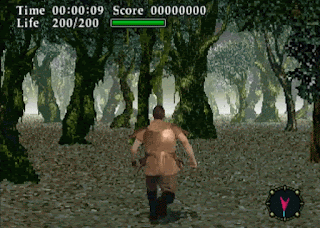Publisher: Sega
Played on: Sega Mega Drive Ultimate Collection
Sega's Super Scaler Technology engine is known for powering 80s arcade classics like Outrun, Hang On, Afterburner and Space Harrier. However, some of its titles fell into relative obscurity. Often, the reason behind this was due to poor home ports in the west.
I've previously reviewed Thunder Blade for the Sega Master System and as one would expect, it was a farcry from the arcade original. It was a decent vertical SHMUP with some truly terrible and choppy 3D-ish sections.
Super Thunder Blade however was a Japanese launch title for its successor, the Mega Drive. If Sega intended to show off the power behind its new 16-bit system a proper port of Thunder blade would have stood out from the crowd. Sadly, Super Thunder Blade brings mixed results; while anyone could tell at a glance this was not running on an 8-bit system, it also made it abundantly clear the Genesis could not properly emulate its arcade counterpart.
Much to my dismay, the vertical scrolling sections found both in the arcade and Master System versions of Thunder Blade were removed. The 8-bit version lacked scaling graphics during these segments, but despite this, they were the still most entertaining part so seeing them removed from its 16-bit descendant automatically raises a red flag. This would have been acceptable had the pseudo-3D portions remained intact, which unfortunately, they do not.
 Yes, graphically, this game is leaps and bounds ahead of the Master System port, it also runs much smoother though that's not saying much. With all that said, this game is still pretty ugly, buildings look like they're paper cut outs and the scrolling is still nowhere near as fluid as one would hope. This problem becomes especially pronounced during the second stage where players are expected to dodge pillars that provide little to no reaction time.
Yes, graphically, this game is leaps and bounds ahead of the Master System port, it also runs much smoother though that's not saying much. With all that said, this game is still pretty ugly, buildings look like they're paper cut outs and the scrolling is still nowhere near as fluid as one would hope. This problem becomes especially pronounced during the second stage where players are expected to dodge pillars that provide little to no reaction time.Engaging in combat is simple but boring. All shots are aimed at where your helicopter is, conversely, you are armed with a limitless supply of seeking missiles. As a result, enemy fire can easily be avoided by circling around the screen while letting your home shots do all the work, this technique also applies to mid-level bosses making them ridiculously easy. The few times I died were most often associated with environmental hazards on level two or end-stage boss fights.
Towards the end of a mission Super Thunder Blade shifts its perspective to that of an overhead shooter, similar to its arcade and Master System equivalents. However, during these segments your helicopter is stuck to the bottom of the screen, meaning the player is only allowed to maneuver left or right. Why Sega decided to limit player control like this is beyond me. Another strange design decision lies with its difficulty curve. The difficulty reaches its apex at level two, once past that hurdle Super Thunder Blade becomes relatively easy.
Sadly, there is little else to say about the game. With only four short missions, Super Thunder Blade can be finished in under half an hour and considering there are no power-ups to pick I found myself simply circling around the screen and taking out everything in my path.
From a technical standpoint, Super Thunder Blade features impressive visuals which could never be reproduced by Nintendo's Famicom. On one hand it showed just what the Sega Mega Drive/ Genesis was capable of, but it was just as successful in displaying its limitations. It's true games like Outrun and Panorama Cotton did a much better job at pushing the pseudo-3D limits of Sega's blast processing machine, but these would not be launched for another three and six years respectively. In the end, I think it speaks volumes that I would rather play the 8-bit version instead of its 16-bit sequel.
Trivia: Despite Thunder Blade being a fairly popular arcade game in the 80s it wasn't until 2015 that western audiences finally received an arcade-perfect port.
Trivia: Despite Thunder Blade being a fairly popular arcade game in the 80s it wasn't until 2015 that western audiences finally received an arcade-perfect port.
Pros:
- As a Japanese launch game for the Mega Drive it can be considered a historic title
- Scaling graphics hold a certain charm despite being subpar by Genesis standards
- Scaling graphics hold a certain charm despite being subpar by Genesis standards
Cons:
- Graphically below average when compared to latter Genesis/ Mega Drive titles
- Graphically below average when compared to latter Genesis/ Mega Drive titles
- Choppy scaling effects make it difficult to avoid environmental hazards
- Only four levels which can be finished in under half an hour
Final Grade: D













